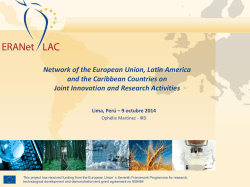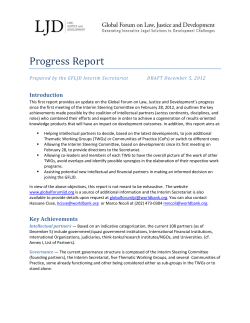
AMANAC general presentation!
Call: H2020-EeB-4-2014 AMANAC ADVANCED MATERIAL & NANOTECHNOLOGY CLUSTER And Coordination Support Action (CSA) http://www.amanac.eu/ Contents • Who are we: What is AMANAC - Aim and scope of AMANAC - How is it linked to the AMANAC-CSA? • How and What: Planned actions in the frame of AMANAC • Benefits from participating in AMANAC • Expectations from AMANAC participating projects AMANAC and AMANAC CSA 2 AMANAC and AMANAC-CSA • AMANAC is the cluster of all projects developing advanced materials and nanotechnologies for energy efficiency in buildings and funded under FP7 or H2020. • AMANAC-CSA is an action aiming to coordinate and promote that activities of AMANAC. AMANAC and AMANAC CSA 3 AMANAC Motivation • Increase visibility of the Materials domain. • Develop market driven efforts to bridge the existing “valley of death” between the knowledge-based science and the successful commercialization of advanced materials and products. AMANAC and AMANAC CSA 4 AMANAC Aim Support the objectives established by the EC and the EeB-PPP, in terms of Energy Efficiency in buildings Maximize the impact of the cluster participating projects towards the European Industry and Society Create long lasting collaboration and coordination platform within all the AMANAC projects Address in a holistic way the relevant technical/technological, industrial, economic, societal, organizational and regulatory challenges AMANAC and AMANAC CSA 5 Impact Exploiting Results and Generating Income for Europe Disseminating Knowledge and Stimulating Industry World-Wide Dissemination Promoting Excellence and Creating Greater Cohesion in the energy, construction and Nanomaterials R&D Community Increasing European added value Fostering European collaboration EXPECTED IMPACT AMANAC and AMANAC CSA 6 Flow of Information AMANACCSA AMANAC Cluster 6 Thematic areas 6 Thematic areas • Communication with project partners, through website and good coordination strategy • Project partners approached via the Thematic Areas; • Project coordinators and partners participate in Thematic Area activities • Thematic Area leaders represent corresponding projects . AMANAC and AMANAC CSA 7 AMANAC participating projects • AMANAC was initiated in April 2014, representing 28 FP7 projects, grouped in six Thematic Areas • Thematic Areas are re-defined when projects finish and when new H2020 projects enter the Cluster, covering new topics. • AMANAC currently represents 255 project partners, out of which 63% are Large Enterprises or SMEs. AMANAC and AMANAC CSA 8 AMANAC-CSA partners • 9 beneficiaries (2 SMEs, 4 Research Org., 3 Universities) Greece England Spain Poland Italy Germany Sweden • Starting date: 01.01.2015 • Duration: 24 months AMANAC and AMANAC CSA 9 THEMATIC AREAS Thematic Area Leader (and representative in the CSA) TECNALIA CETMA UBT NTUA UBAH NTUA (tentative) Thematic Area High performance insulation materials, systems & Nanotechnologies for HVAC systems Materials with reduced embodied energy Novel materials for smart windows Nanotechnologies for multifunctional lightweight construction materials and components Technologies and materials for a healthier indoor environment Pilot Production AMANAC and AMANAC CSA 10 Projects in AMANAC • AMANAC-CSA is open to all AMANAC projects • Every current or future project will be assigned to its closest “Thematic Area”. • All projects can be involved in Thematic Areas, Committees and Advisory Boards • Each project will contribute to the development of the CSA Joint Action Plan and the Action Plan of its thematic area. • All projects will have access to the AMANAC committees, to training events, to communication and dissemination activities, to the project WiKi, web exchange platform etc. AMANAC and AMANAC CSA 11 Projects in AMANAC • New projects can be informed on common activities, workshops, conferences etc. through the website and could contact the coordinator of the thematic area that their project would like to get informed with more news. • Finalized projects will be kept on board through the wi-ki (new technologies, methodologies). They could remain on stakeholder list and be involved as member of the Industrial Advisory Board. • The final presentation of all projects to be uploaded on website. AMANAC and AMANAC CSA 12 AMANAC Thematic Areas Each thematic Area: • Develops its own “Action Plan”, which is regularly updated. • Develops databases with new/vital information that can be shared among projects • Organizes events (e.g. workshops, stakeholders meetings) • Participates in intern. and EU events via the thematic area leader. AMANAC and AMANAC CSA 13 AMANAC-CSA Committees • AMANAC-CSA management: Steering Committee, Cluster Advisory Board (Experts from AMANAC projects) • Participating Project Clustering: Joint Action Plan Committee and six Thematic Working groups, one for each of the six Thematic Areas • Exploitation: Industrial Advisory Board, LCA/LCC committee, Standardisation committee AMANAC and AMANAC CSA 14 Planned Activities -1 • AMANAC-CSA starting date: 1 Jan 2015 Type of Dissemination activity Web-page Wi-ki Item Estimated date 1 1 M5 M5 One every 6 months e.g.: M5, M12, M18, M23 M7 M12 Three in the first year and three in the second year: M4, M8, M12, M16, M20, M24 E-newsletters 4 Poster Leaflet/Brochure 1 1 Thematic workshops 6 Training event on IPR/standardization Training event on nanosafety Open Info Day Fairs E2B events/ ECTP Video Short name of lead beneficiary NTUA UBAH FASADA FASADA FASADA Each Thematic Area leader 1 M11 FhG-ICT 1 2 4 2 1 M18 M12, M22 Two per year One per year M24 TEC FhG-ICT TWI TWI CBI AMANAC and AMANAC CSA 15 Planned Activities that require interactions with projects • Joint Action Plan (TEC, M3) • Planning of large scale events for 2016 – Joint forces to increase impact and reduce costs (TWI) • Organization of “open days” for 2015-2016 (FhG-ICT) • Committee on requirements for product standardization (TWI, M6) • Life Cycle Assessment and Life Cycle Costing committee; Database in Wiki (NTUA, M17) • Database on nanosafety aspects (UBAH, M23) • Inventory of available and reusable demo buildings (FhG-ICT, M23) • Inventory of pilot production lines (NTUA, M23) AMANAC and AMANAC CSA 16 Benefits for participating projects • Increased visibility of project results & achievements – Continuation after project end • New collaborations; cross project joint publications • Harmonized approaches in key issues (LCA/LCC, safety, standardization) • Access to AMANAC databases • Access to the AMANAC committees • Access to training events and related material • Access to the AMANAC WiKi, web exchange platform etc. AMANAC and AMANAC CSA 17 Expectations from participating projects • Provide information on achievements, event organization etc. • Populate AMANAC web site and wi-ki • Provide expert contacts for standardization and LCA/LCC committees • Participate in events • Each Thematic Areas: Updated Action Plan; Poster; Leaflet AMANAC and AMANAC CSA 18 AMANAC Website The AMANAC website is active under the link: http://www.amanac.eu/ AMANAC and AMANAC CSA 19 AMANAC contact For more information, please contact: Project Coordinator: Prof. M. Founti (NTUA) E-mail: mfou@central.ntua.gr AMANAC and AMANAC CSA 20
© Copyright 2025










